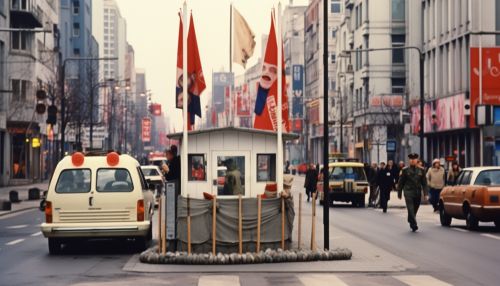Checkpoint Charlie
Introduction
Checkpoint Charlie (Cold War) was a notable crossing point in the Berlin Wall between East Berlin and West Berlin during the Cold War. Named by the Western Allies, it was the third checkpoint opened by the Allies in and around Berlin, the other two being Helmstedt-Marienborn (Checkpoint Alpha) and Dreilinden-Drewitz (Checkpoint Bravo). The name "Charlie" came from the letter C in the NATO phonetic alphabet, following the same pattern of the other two checkpoints.
Background
Following the end of World War II, Germany was divided into four zones of occupation under the control of the United States, the United Kingdom, France, and the Soviet Union. Berlin, the German capital, was similarly divided, with the eastern portion of the city becoming the capital of the German Democratic Republic (GDR, or East Germany), a satellite state of the Soviet Union. The western sectors of Berlin, although geographically within East Germany, were administered by the Western Allies and became an enclave of West Germany.
Establishment
Checkpoint Charlie was established on 14 August 1961, two days after the construction of the Berlin Wall began. It was a small wooden shed initially, replaced by a larger metal structure in the mid-1960s, and finally by a booth and signboards in the late 1980s. The checkpoint was located at the junction of Friedrichstraße with Zimmerstraße and Mauerstraße (which for older historical reasons coincidentally means 'Wall Street'). It was the only crossing point for foreigners and members of the Allied forces.
Role during the Cold War
Checkpoint Charlie became a symbol of the Cold War, representing the separation of East and West, and — for some East Germans — a gateway to freedom. The checkpoint was frequently the site of escape attempts by East Germans, and it was also the site of several significant events during the Cold War.


One of the most notable incidents at Checkpoint Charlie occurred in October 1961, when U.S. and Soviet tanks faced off at the checkpoint during a dispute over whether East German guards were authorized to examine the travel documents of a U.S. diplomat passing through to East Berlin. The standoff ended peacefully, but it was one of the highest tension moments of the Cold War.
Post-Cold War era
After the fall of the Berlin Wall in 1989, Checkpoint Charlie was officially closed on 22 June 1990. The guardhouse was removed and is now on display at the Allied Museum in Berlin-Zehlendorf. A copy of the guardhouse and sign that once marked the border crossing was later erected at the original site as a tourist attraction.
Legacy
Today, Checkpoint Charlie is one of the most-visited tourist attractions in Berlin. The site includes a museum, the Mauermuseum, which is dedicated to the history of the Berlin Wall and the stories of those who attempted to escape from East to West. The museum was founded by Rainer Hildebrandt, a human rights activist, just months after the construction of the Wall.
